- Kia ora
- Ōtaki Gorge Road
- Bridges nearing completion
- From the air – work underway in the south of the project
- Dangerous Crossings
- State Highway 1 diversion
- Katihiku Marae – blessing of offsite mitigation works
- Ecological challenges of the Waitohu Stream
- Last concrete pour for Bridge 1 in the northern construction zone
- Ōtaki to north of Levin
- State Highway 1 diversion
- Upcoming construction milestones
- Safety changes around Ōtaki River Bridge
 Kia ora
Kia ora
We continue to make good progress on the construction of the new Peka Peka to Ōtaki (PP2Ō) Expressway but, as with all construction projects, it’s not without its challenges.
In order to build the permanent intersection of Ōtaki Gorge Road and the existing State Highway 1 (SH1), it will be necessary to make some temporary changes to both SH1 and Ōtaki Gorge Road.
The new Ōtaki Gorge Road partial interchange will be up to 2.5m higher than the existing road level, which means the road needs to be raised. To undertake this work safely, we need to close Ōtaki Gorge Road for a short period of time.
We have carefully considered all the available options to ensure that whatever we decided would be the least disruptive option. The option we believe will serve the community best is a closure of 11 weeks, which is tentatively scheduled to take place in February/March next year.
For the proposed option, there will be five construction stages which are outlined later in this newsletter. The first is the SH1 diversion just south of the River Bridge planned for mid-December (weather permitting). The final stage prior to the permanent configuration will involve switching SH1 traffic from the diversion up and over the partial interchange at Ōtaki Gorge Road. Only Stage 3 requires the temporary closure of Ōtaki Gorge Road.
We know that this will cause disruption for residents and are committed to working with the community to keep everyone updated, and to try and minimise any impact.
We are planning to time the closure of Ōtaki Gorge Road with the opening of the School Road overbridge, meaning that Ōtaki Gorge Road traffic will be diverted down School Road over the bridge crossing SH1 and the rail line, to access SH1 via Te Horo Beach Road.
I would like to reiterate that we have considered several different options to see whether we could avoid closing Ōtaki Gorge Road. For our team to be able to safely and efficiently complete the necessary work, the other options simply weren’t viable.
In other news, we have all recently been reminded of the need to keep safe and follow the COVID-19 guidelines put in place by the Government. Events in both Auckland and Wellington have shown us how important it is to remain vigilant. Everyone coming on to the PP2Ō site must sign in. We ask all visitors to use the COVID-19 QR code tracker, respect social distancing and practise good hygiene.
Stay safe until next time.
If you need any further information on the PP2Ō Expressway project, please call us on 0800 PP2O INFO or email pp2o@nzta.govt.nz
Ngā mihi
Chris Hunt, Project Director
Ōtaki Gorge Road
As we shared earlier, essential work at the Ōtaki Gorge Road (OGR) intersection with SH1 means we have to close OGR for a period.
After considering several options, we have identified that the least disruptive option will be an 11-week closure of OGR from February (weather dependant) to allow the partial interchange to be constructed. During this period, a detour will be in place along Hautere Cross Road and School Road.
The closure of the road has been timed to align with the opening of the School Road overbridge, which will allow traffic to pass over SH1 and the railway tracks and then onto Te Horo Beach Road for access to SH1. The intersection will have some safety modifications applied prior to the bridge opening, and we are also looking at speed limits for the area.
The work will be undertaken in five stages. The first stage if the diversion south of the Ōtaki River Bridge and we expect to switch traffic in early to mid-December, 2020. Only stage 3 requires Ōtaki Gorge Road to be closed and that work is expected to get underway in February 2021 and last for 11 weeks. Once the traffic management plan is finalised, we will circulate it widely.
Bridges nearing completion
We are making steady progress on the 10 bridges that feature across the PP2Ō project, and many of the structures will be completed in the coming weeks.
While you’ll see the dumper trucks and other construction traffic moving across some of them, it’ll still be a while before most are opened to the public.
By allowing project traffic and trucks to use the infrastructure, we can remove them from the roads around Ōtaki and help reduce congestion. Structures to watch in the coming weeks and months are:
Taylors Road – Bridge 1
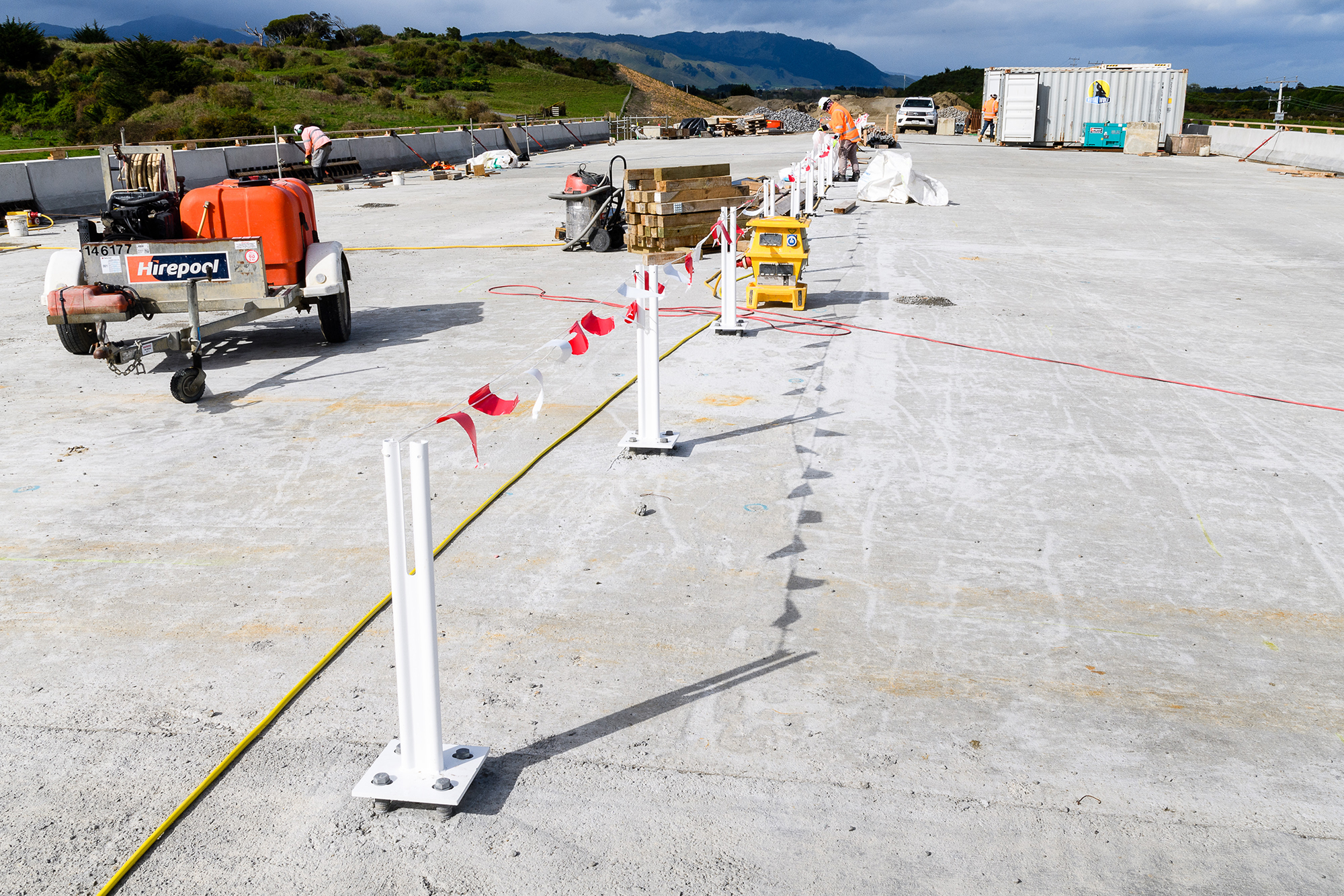
Work continues on Bridge 1 over the Waitohu Stream.
Construction traffic started the week of 9 November 2020 following the completion of Bridge 1. However, works are still required to complete a reinforced earth embankment on the northern side of the road, using sand from the southern side. The bridge will ultimately open to the public as part of the full expressway opening.
Ōtaki River Bridge – Bridge 5
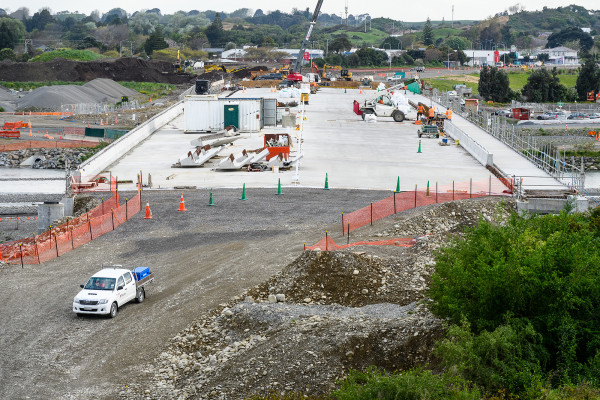
Construction traffic will be redirected over the Ōtaki River Bridge prior to Christmas.
Bridge 5 will be open for construction traffic just before Christmas this year, but no plans are in place to use it for any major haul routes right now. There will just be a small number of construction vehicles using it, with the odd concrete truck and delivery up on the deck.
In the new year, we intend using Bridge 5 as an access for light vehicles’ access and to deliver asphalt to the south end of the project. This is another way we’ll be keeping construction traffic off public roads.
Ōtaki Gorge Road and SH1 intersection – Bridges 6 and 7
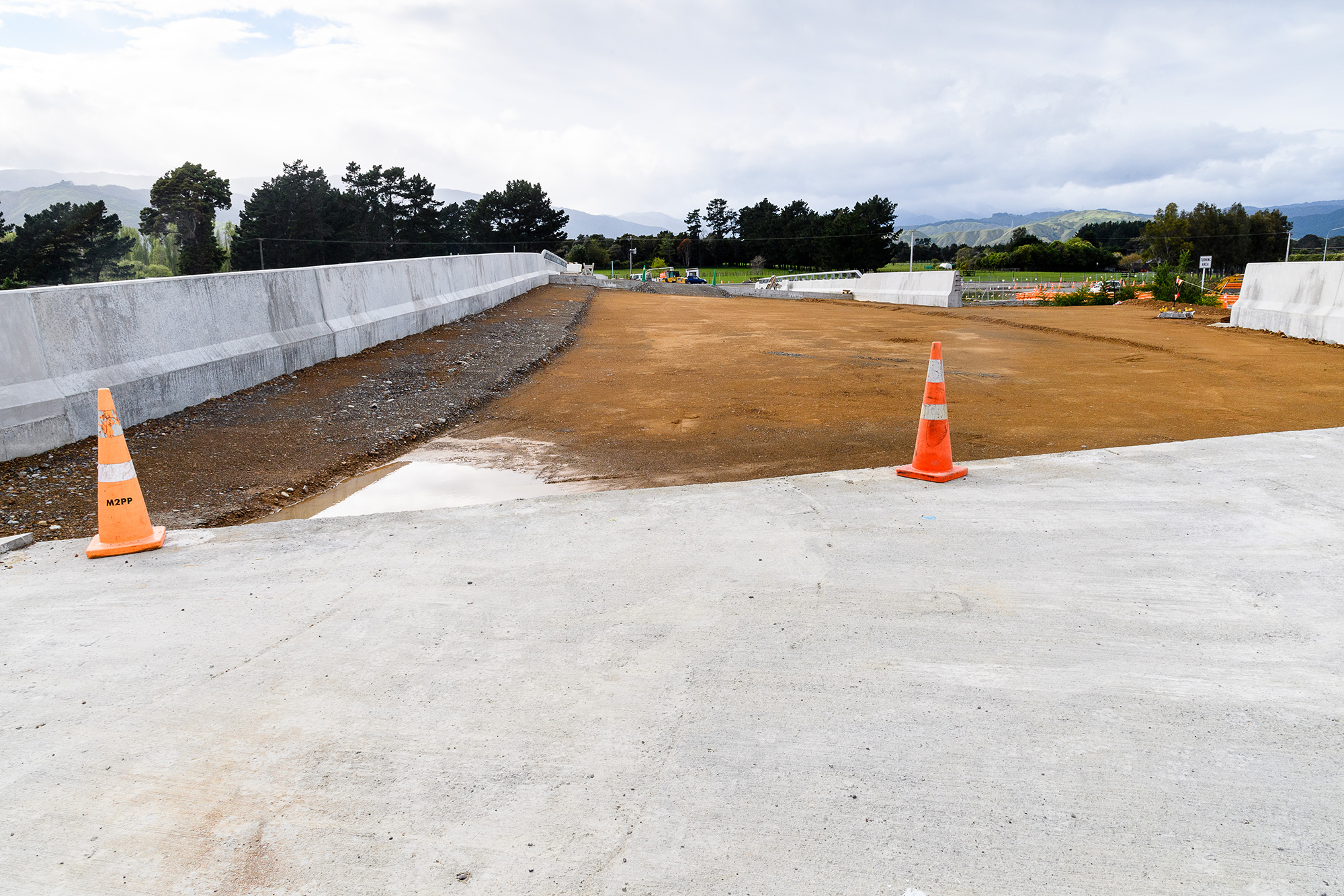
Bridges 6 and 7 are getting ready for the pavements team.
These two bridges, over the new expressway and railway line are planned to open to the public towards mid-2021. They are both dependent on the completion of work at the Ōtaki Gorge Road/SH1 intersection.
Te Horo Overpass – Bridge 8
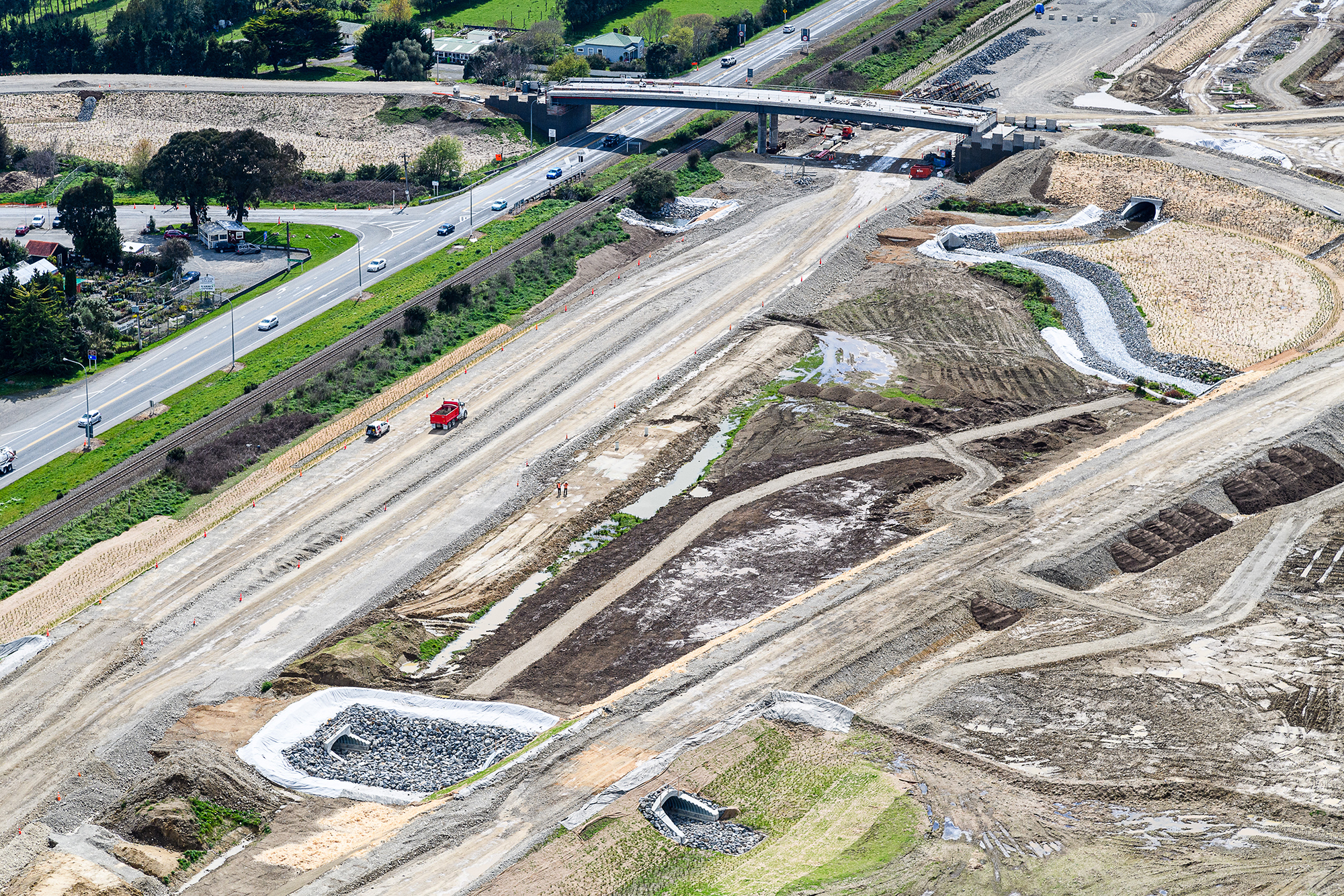
Progress on bridge 8 air (taken in September 2020).
This bridge is scheduled to open to the public in first quarter of 2021. Until then, the bridge will be used by construction vehicles.
From the air – work underway in the south of the project
It’s sometimes hard to see all the work underway on PP2Ō, but with a bird’s eye view, you can really see the new expressway taking shape. Earthmoving on the southern end of the project has been a focus for the team over the past few months.
Dangerous crossings
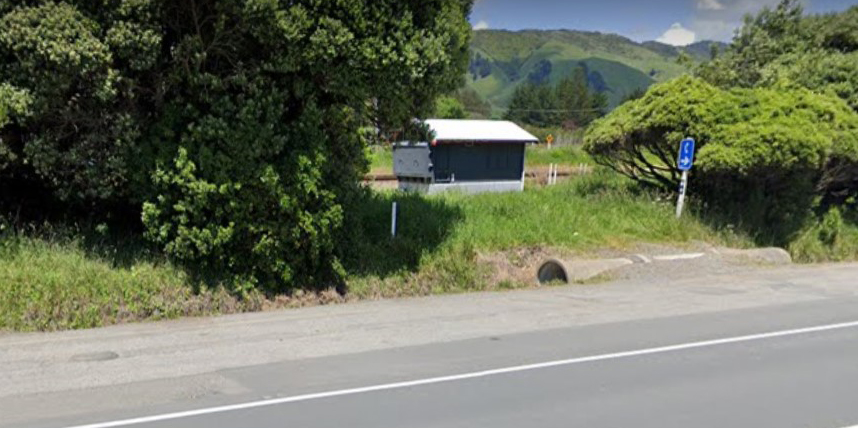
The area being used as an accessway to the expressway designation. A fence now surrounds the area and we ask people not to put themselves at risk by entering it.
We are increasingly concerned at the number of people walking across the rail track and the PP2Ō Expressway designation to access School Road from SH1 at Te Horo.
Our project team is aware of children and adults walking across the area with prams, toddlers and dogs in tow. We have fenced off the designation area and ask people not to breach the boundary for their own safety. We are extremely concerned that someone may be hurt by being somewhere they shouldn’t.
We have many dump trucks working in this, and it is very hard to see people scrambling up and down banks and passing through muddy construction areas.
Our staff have stopped people trying to enter the site and explained the dangers, only to find that they have still entered the site later.
The area has the typical construction hazards of heavy vehicle movement and uneven surfaces. It is a hazardous area that is subject to constant change. The track and the land surrounding the tracks is called the rail corridor. Unless you have a valid permit to be in the rail corridor you are trespassing and could be held liable for fines of up to $10,000.
Most importantly, people are putting their lives in danger. We don’t want to see anyone hurt on our site, and we appreciate the help of the entire community in keeping everyone safe.
State Highway 1 diversion
With Christmas approaching, there will be one last SH1 traffic switch before we break for the holidays. From the week beginning 13 December 2020 (weather dependant), traffic will be shifted from SH1, just south of Ōtaki River Bridge, onto the temporary road being built to the west of the existing alignment.
This switch will let the project team start work on the partial interchange at Ōtaki Gorge Road. This will ultimately allow us to move local road traffic onto the new alignment, so that we can use the existing Ōtaki Gorge Road for access to complete the expressway through this section.
A proposed 50km/h speed limit in the area is under discussion.
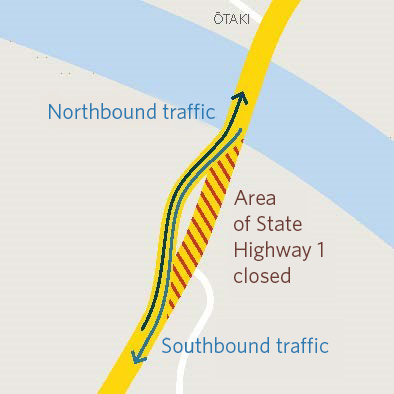
Katihiku Marae – blessing of offsite mitigation works
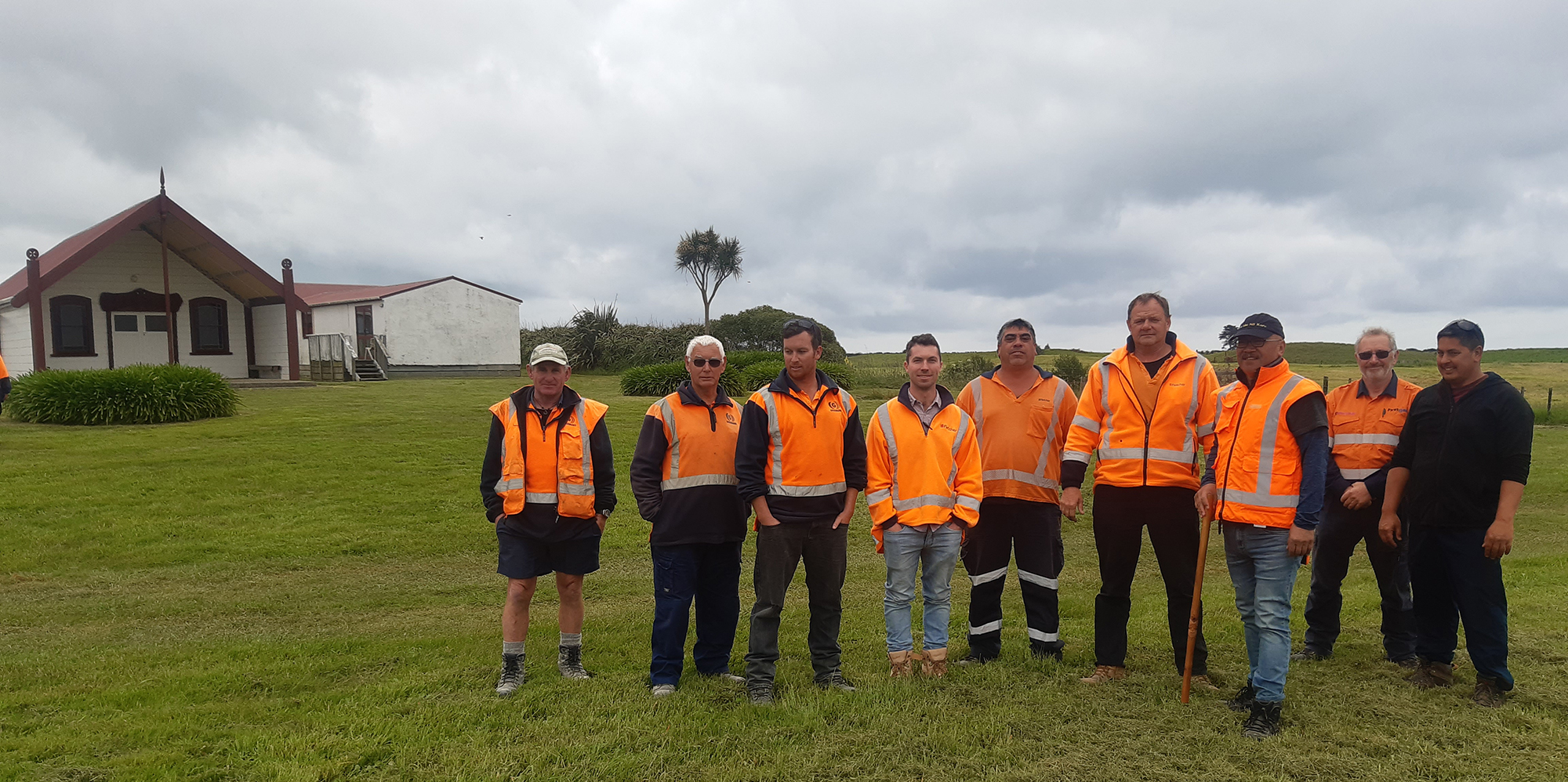
The team at the blessing of Katihiku Marae Bund.
On Monday 2 November 2020, members of the PP2Ō team were invited to Katihiku Marae for a blessing of the work taking place on the marae.
As part of mitigation work around the expressway, a flood bund is being built to protect the marae from a flood event significant enough to top the Ōtaki River stop banks (a one-in-20-year flood event). The bund is 1m high and built out of low permeability fill that has been dug out from the old School and Gear Road areas.
The total volume of earth in the bund will be around 550m3. It will be transported to site by truck, then placed and shaped by an excavator, and lastly compacted with a flat-drum roller. When the bund is finished, a 100mm layer of topsoil will be applied and sowed with grass seed.
The bund is expected to take around two weeks to build, including the silt placement, shaping of swales, installation of pipework and application of topsoil.
Ecological challenges of the Waitohu Stream
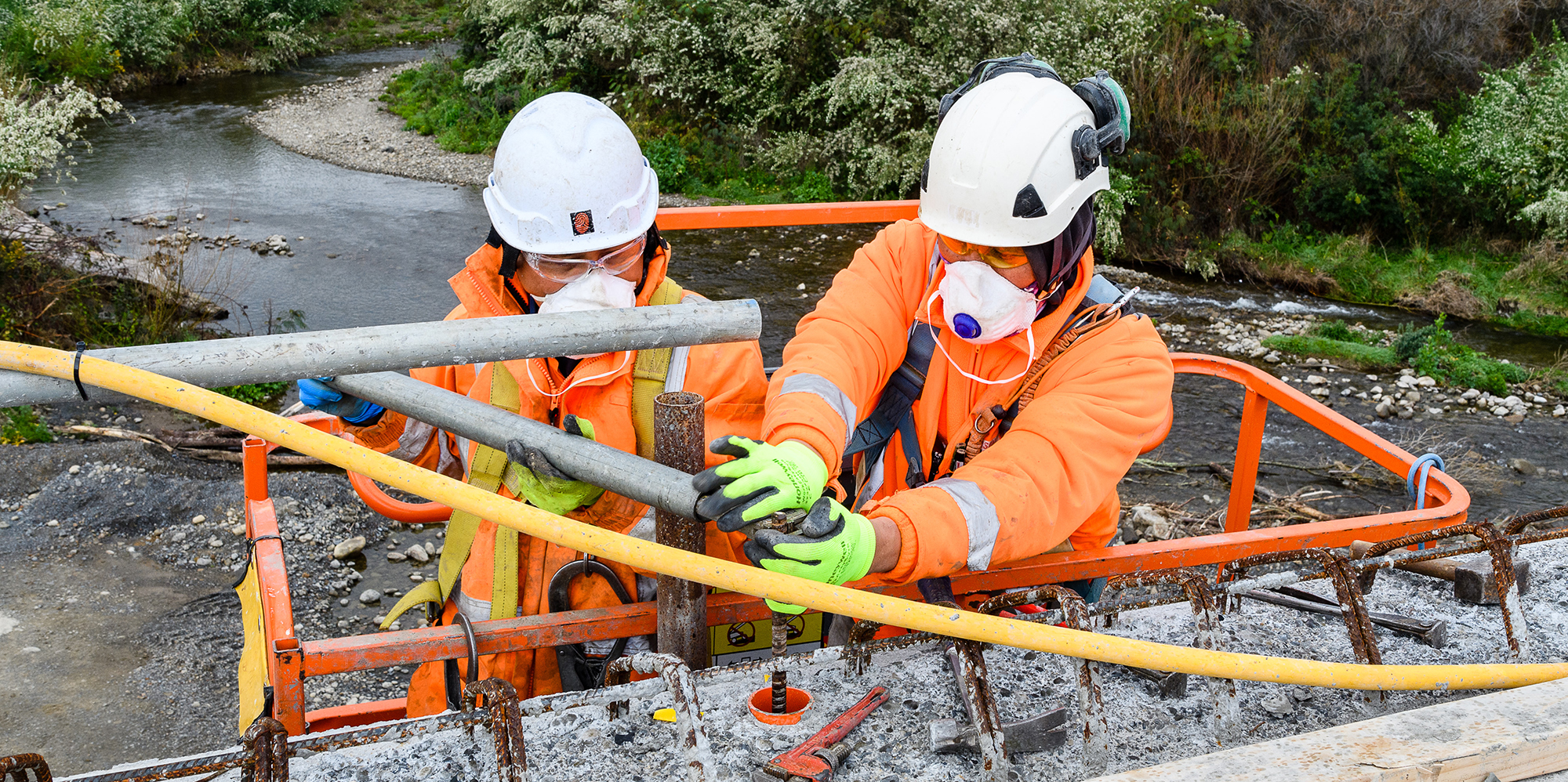
Building a bridge over a live stream presents unique challenges.
The PP2Ō environmental team is familiar with the difficulties of preserving ecological harmony in rivers and streams while building large concrete structures above. However, the building of Bridge 1 over the Waitohu Stream presented the team with some unique ecological challenges.
The first step, even before the foundations of bridge 1 were dug, was conducting a fish survey to understand what fish species live in the stream.
One of the main mitigation activities for in-stream works was to confirm the number of fish species found during the quarterly electric fishing survey. This survey in September 2020 identified the numbers of each fish species observed in the stream over a 24–26 minute period. The species present during the Waitohu stream survey are listed below.
The table shows the numbers of each fish species identified during the survey time of 24–26 minutes.
| Species | Waitohu upstream | Size range (mm) | Waitohu downstream | Size range (mm) |
|---|---|---|---|---|
| Inanga | 9 | 60–70 | 1 | 65 |
| Redfin bully | 3 | 35–45 | 4 | 35–45 |
| Unidentified eel | – | – | 2 | 80–90 |
| Torrent fish | 3 | 45–50 | 4 | 40–60 |
| Rainbow trout | – | – | 1 | 210 |
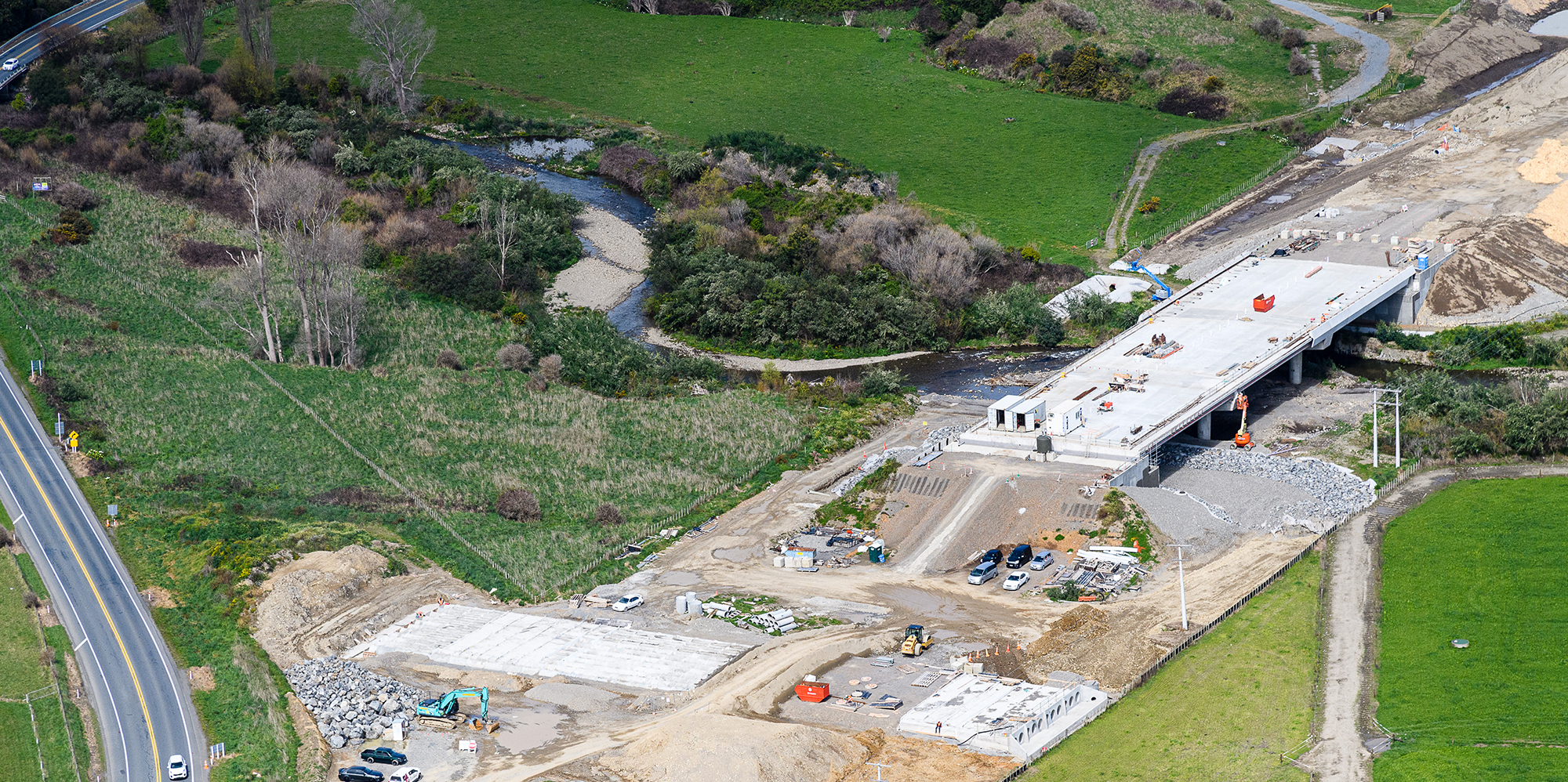
Flying south over Bridge 1.
Last concrete pour for Bridge 1 in the northern construction zone
Our Bridge 1 concrete crew recently reached a major milestone, completing the final concrete barrier stitch pours. (Bridge 1 is the bridge nearest to Taylors Road.)
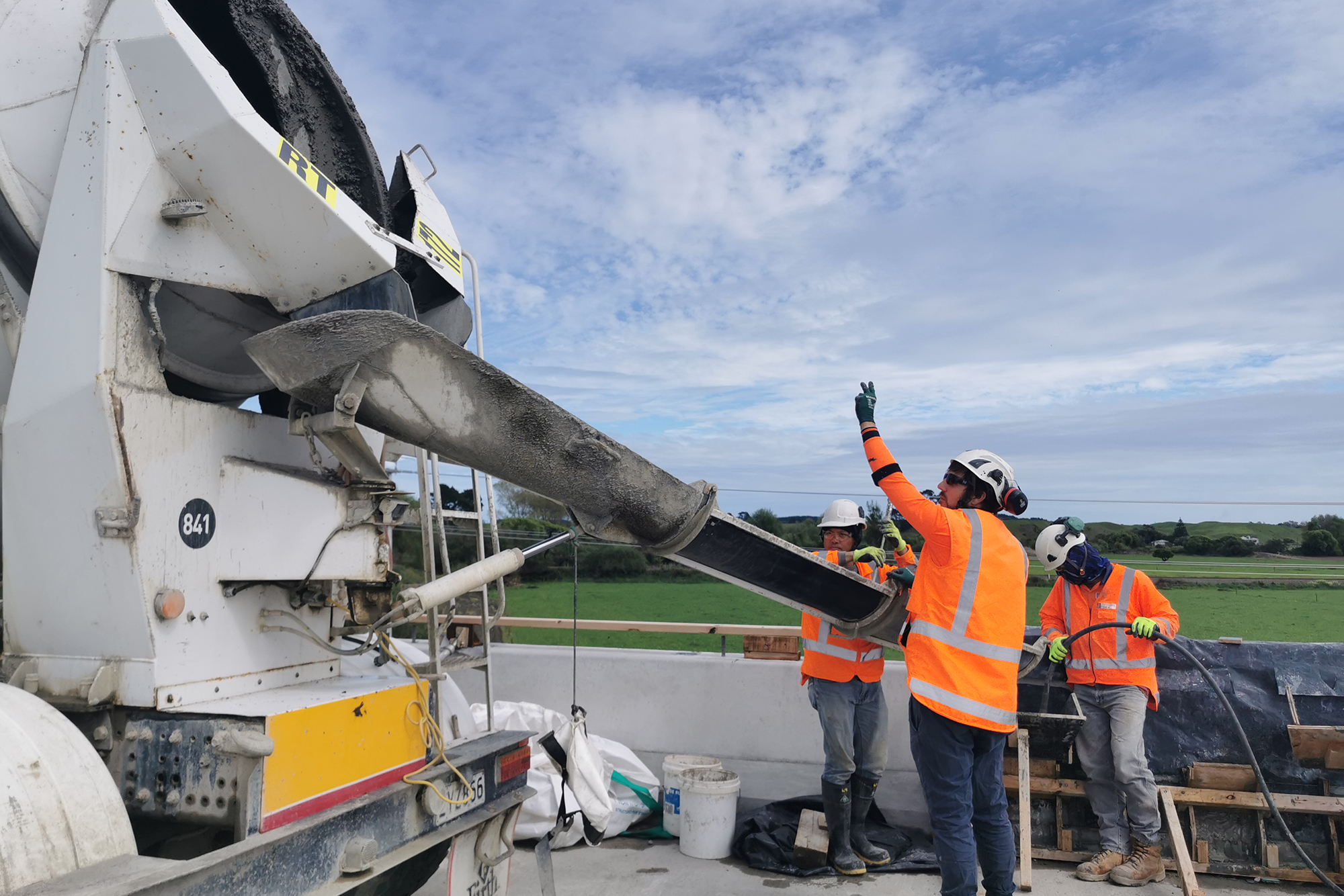
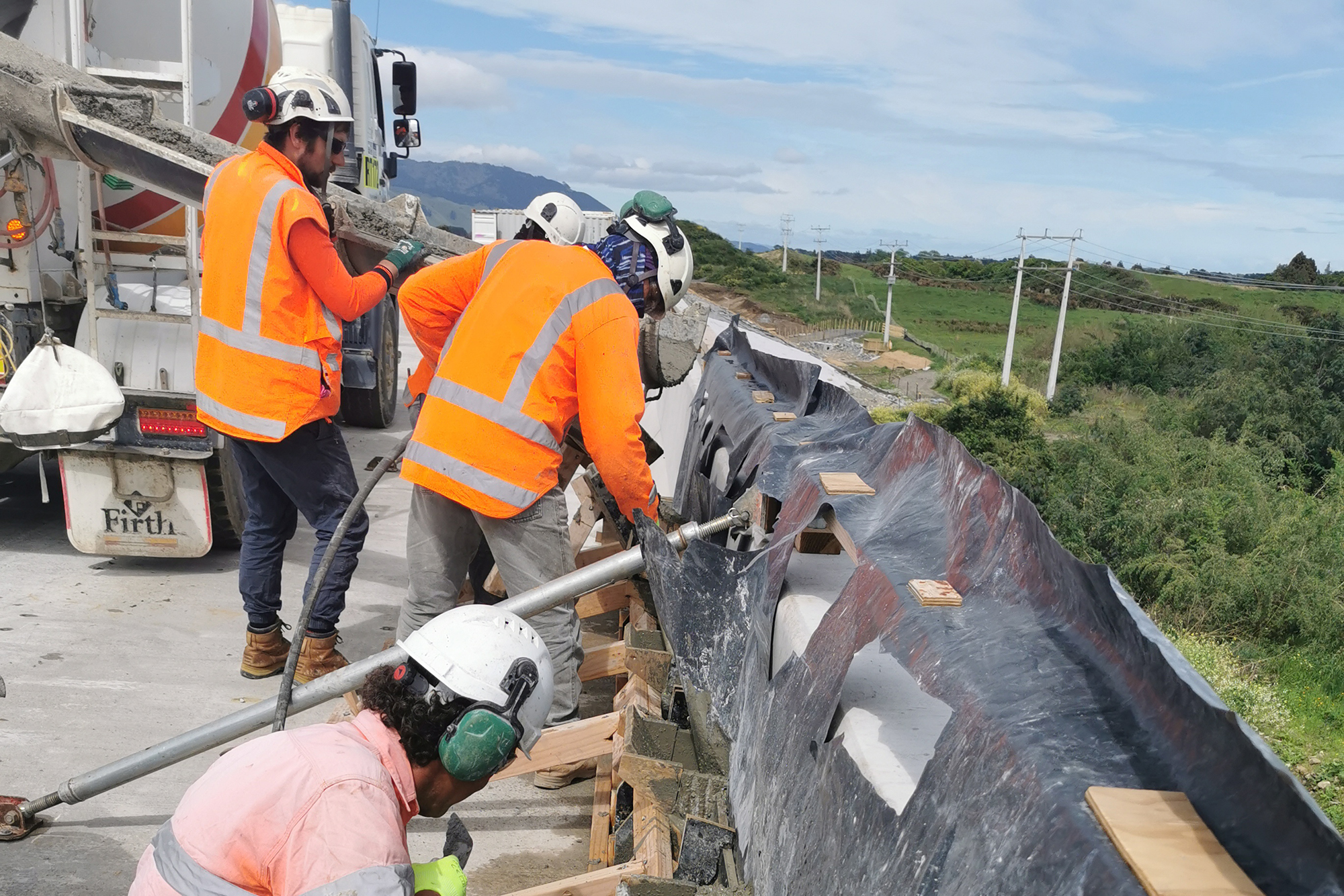
Bridge 1 concrete crew Mark Daly, Normando Aquibel, and Glen Galendez and leading hand Richard Goa.
Leading hand Richard Goa and carpenters Mark Daly, Normando Aquibel, and Glen Galendez managed the delicate process, which included directing a rather large concrete truck onto the deck of the structure.
“It takes patience and precision to make sure the correct amount of concrete is cast and that the concrete truck is directed exactly where you want it to go,” Richard said.
Richard and the team have created their own unique communication style to ensure the operation runs smoothly. Because of the noisy concrete truck and concrete vibrator machines in the background, they use hand signals to confirm and indicate what is happening and ensure everyone is aware of potential hazards. Any mistake could potentially cost someone their life, teamwork and health and safety protocols are strictly followed.
Bridge 1 has 15 individually poured barriers on either side of the structure, with each barrier weighing eight tonnes according to Infrastructure Supervisor Glenn Boyer. The pre-cast bridge barriers are raised on to the bridge structure by crane. Once they are locked into the vertical structure, concrete is poured between the deck and pre-cast barriers to secure the barriers to the bridge deck.
Carpenters frame the bridge barriers with a simple wooden framework, and the mixture is poured into the breaks between the structures. A concrete vibrating machine is slotted into the gaps and the vibration from the machine releases the bubbles in the concrete mixture – like baking a cake and tapping the cakepan to release trapped air bubbles from the batter. This makes the mixture smoother and because there is no oxygen in the concrete, it is less likely that cracks will form when dry. Drying time is around three and a half hours, after which the wooden framework is taken down and the concrete finished to provide a smooth surface.
Ōtaki to north of Levin
Waka Kotahi is already well into planning for a new four-lane highway that will connect to PP2Ō at Ōtaki and continue to north of Levin. A draft preferred alignment for the new highway and connections were shared through a series of community events in August and September. Nearly 800 people attended these events, and there were more than 1300 online visitors to an interactive map of the project.
With this engagement phase complete, feedback from the community is now being considered alongside technical assessments and fieldwork to consider possible refinements. An update on refinements to the alignment and connections is due in early 2021.
Ō2NL project information
Ō2NL consultation posters [PDF, 15 MB]
Upcoming construction milestones
Northern area update
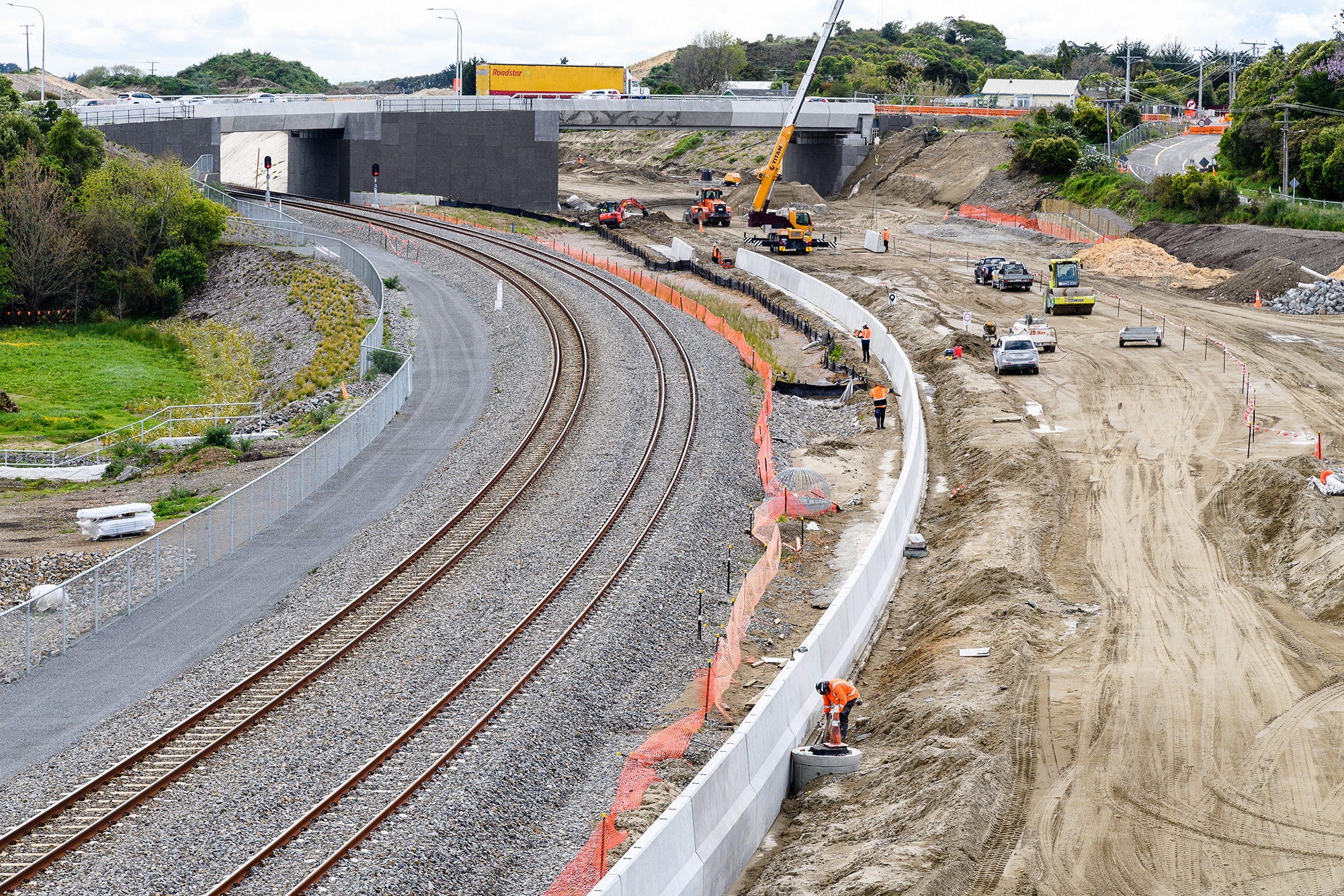
Bridge 2 and 3 at the north of the project.
The Waitohu Stream Bridge (Bridge 1) is now substantially complete and being used to haul fill from south of the Waitohu Stream to the Taylors Road and northern tie-in locations. Most of the drainage is now complete around the Bridge 2 on and off ramp areas, which are being shaped to receive the last of the utility/ITS ducting prior to pavement works. Earthworks at the northern abutment of Bridge 5 (Ōtaki River Bridge) are in full swing with the expressway embankment through this area now rising out of the ground.
Central area update
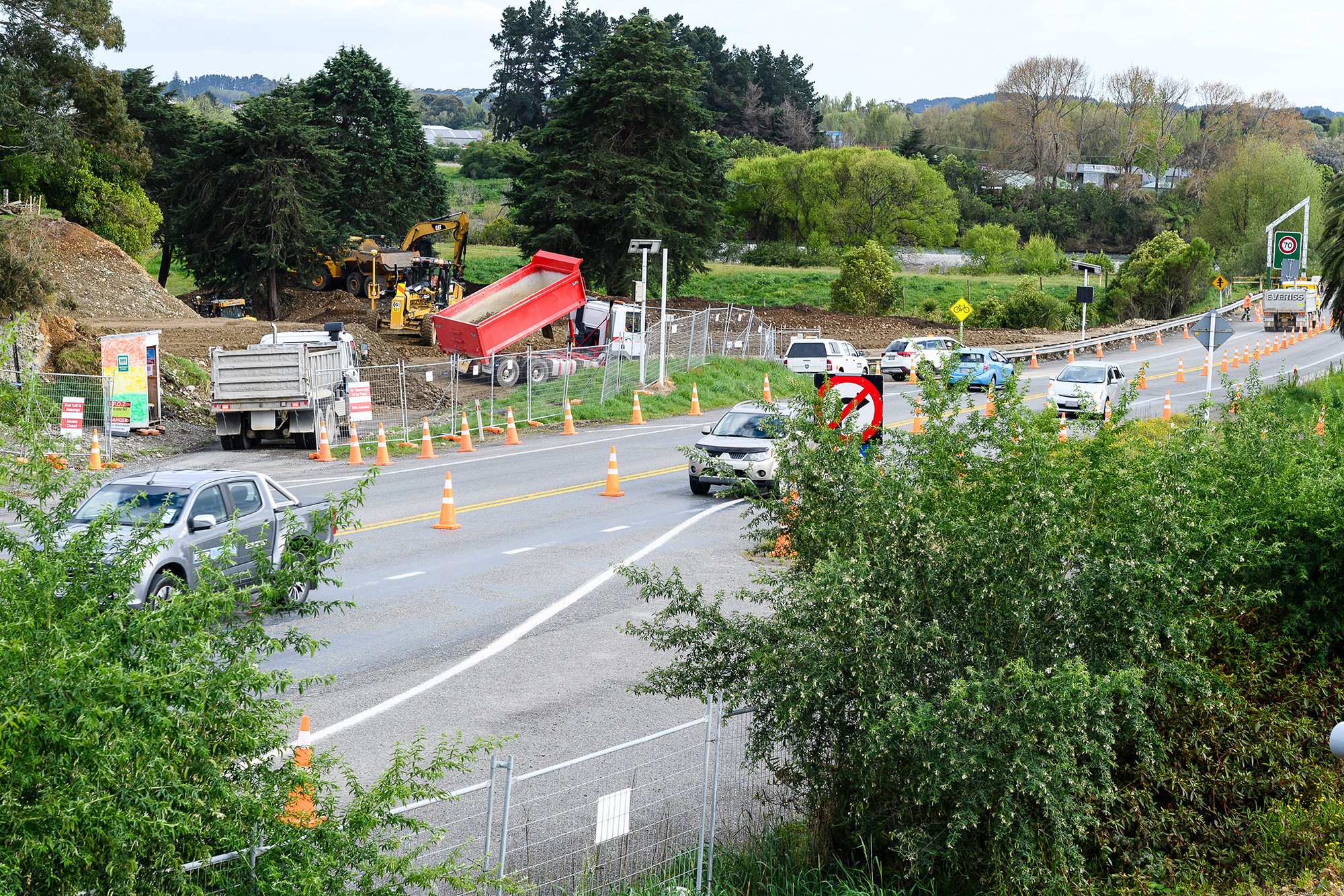
The SH1 diversion south of Ōtaki River Bridge is taking shape.
The first of the pavements have been completed on the temporary section of SH1 adjacent to Ōtaki Gorge Rd. Once all pavements are complete, they’ll be followed by surfacing, which will allow the temporary road to be opened to traffic in late November/early December. Works on the Smisek Kilns will resume in the middle of November with reconstruction of the kilns continuing into the new year. With the Gear Rd/School Rd Stage 1 traffic switch occurring in October, the area of expressway immediately south of the School Rd rail crossing can now be accessed for construction. Bridge 8 (Te Horo) overbridge is progressing well, with all superstructure works to be completed in early to mid-December.
Southern area update
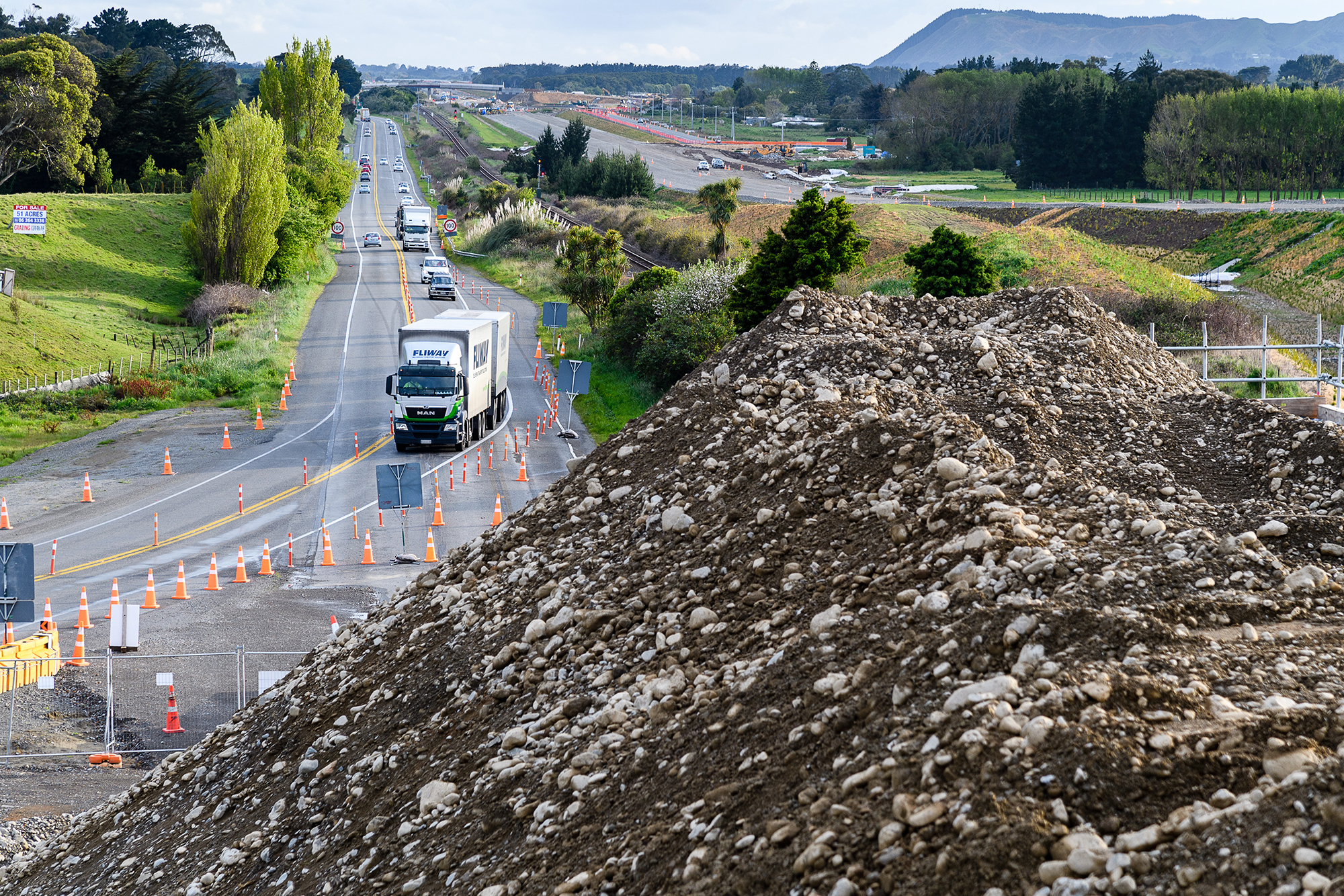
Major earthworks are under way between Makahuri and Peka Peka. This picture is taken near Bridge 9.
With the SH1/LAR traffic switch behind us, the last of the bulk earthworks at the southern end of the expressway are well underway. Between now and the end of the year, the landscape between Makahuri (formerly known as Marycrest) and Peka Peka will change dramatically as the last of the large undercut works are completed. These will be backfilled with the sand preload that has dominated the side of the old SH1 section for the last 12–18 months. Large transverse drainage will also get underway to allow construction of the four lanes of expressway over top of the Awatea and Kumutoto Streams.
Safety changes around Ōtaki River Bridge
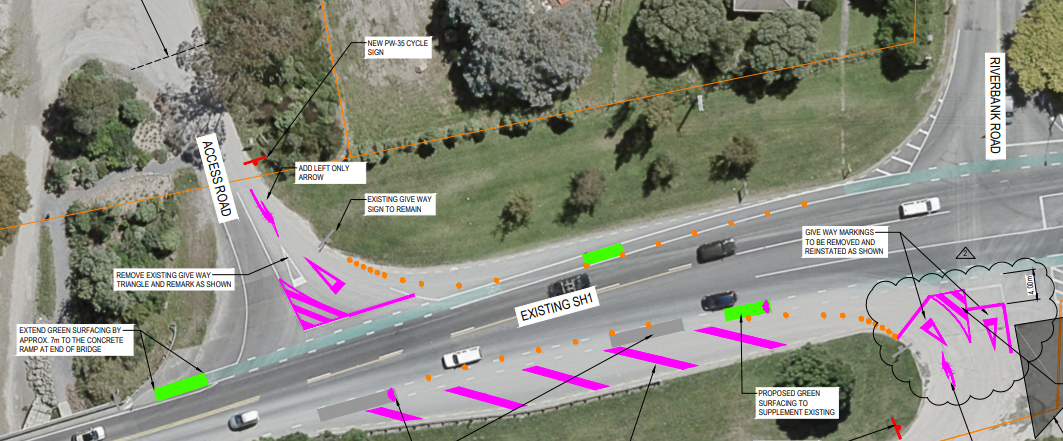
The safety changes being introduced around the access roads.
You may have noticed changes around the access roads either side of SH1 north of the Ōtaki River Bridge.
Waka Kotahi has introduced these changes to improve safety for all road users in anticipation to an increase in truck movements on and off the state highway from the PP2Ō asphalt plant when this becomes operational in early 2021.
The access road on the western side of the road immediately north of the bridge is now left-in and left-out only. The access road on the eastern side remains as a crossroads intersection with a right-turn lane for normal vehicles.
The truck acceleration lane heading south out of the eastern access road has been removed as this acceleration lane was too short for heavy vehicles to gain the sufficient speed needed for safe merging onto the highway. This created safety concerns for vehicles at the merge point and for anyone on a bicycle who may have been between the two lanes.
The change means people may have to briefly slow down as vehicles enter the traffic flow and build up speed. Please be patient – it is only a few seconds’ delay but is a much safer situation for everyone.
A 50km/hr temporary speed limit is proposed to further improve safety for people getting in and out of the access roads, and to make merging easier.
The placement of the safe-hit posts (hit-sticks) on either side of the road offers further protection for people on bikes, as they are able to cycle inside the line of hit-sticks. The placement of the hit-sticks also improves visibility for vehicles turning out of Riverbank Road as, previously, vehicles turning left into Riverbank Road may have obscured the vehicles behind them. Requiring vehicles to now stay in one lane makes it easier to judge the intentions of oncoming traffic.
Finally, additional green paint is being added to indicate the best placement for people on bikes and to alert motorists to their potential presence.
We’ve made these changes after discussions with quarry and asphalt plant operators. We are constantly aiming to improve safety even further, so we welcome any feedback. We will also consider adjustments based on how well these measures are working.
We appreciate your patience as everyone gets used to the changes. Please drive safely, drive carefully, and stick to the posted speed limits.
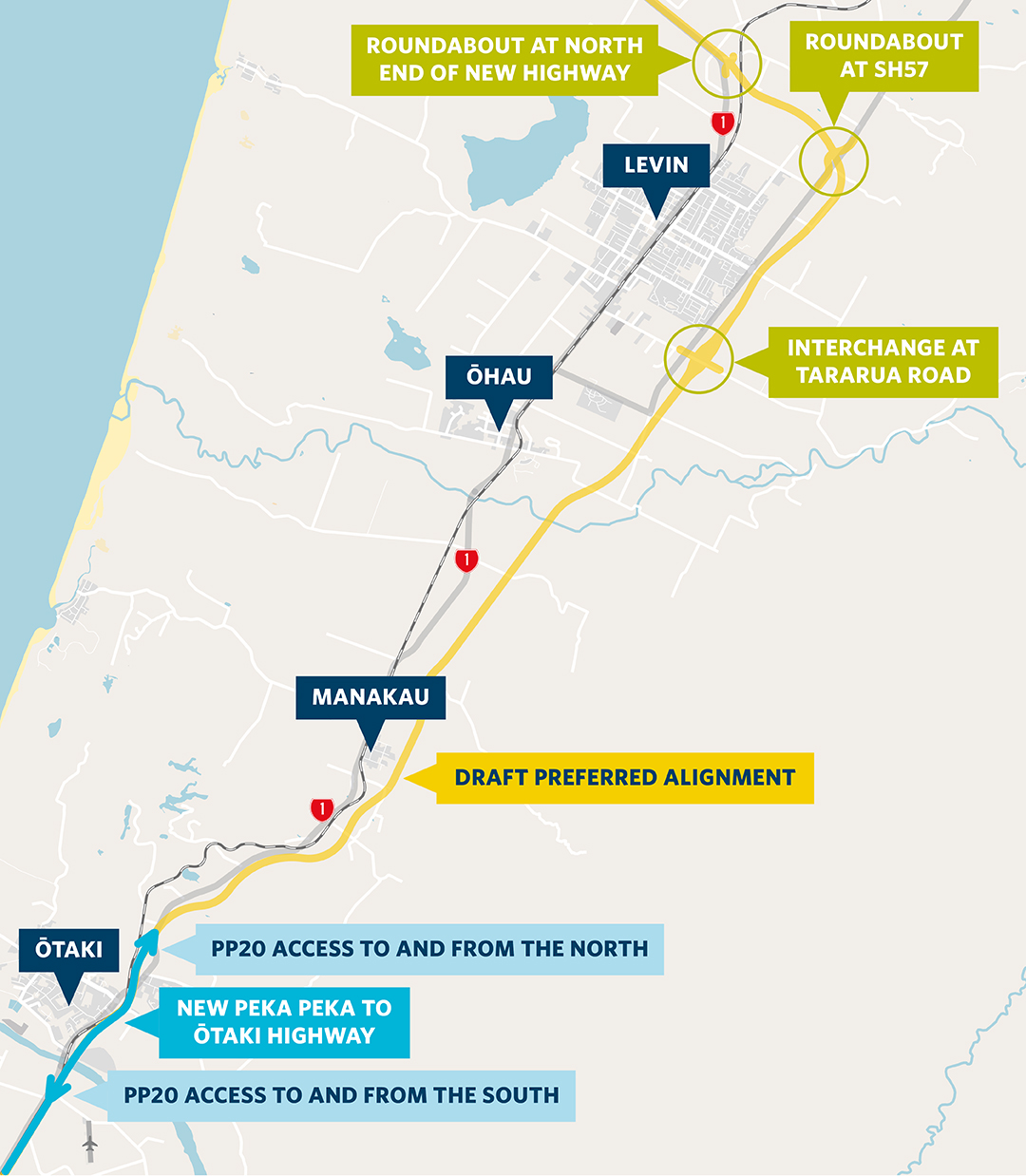 View larger map
View larger map